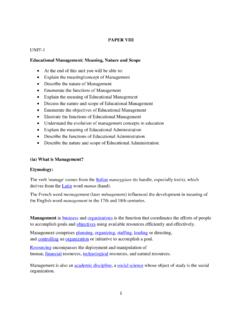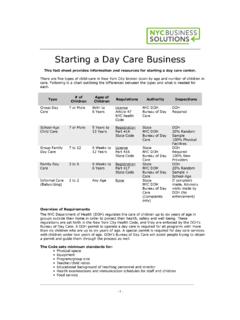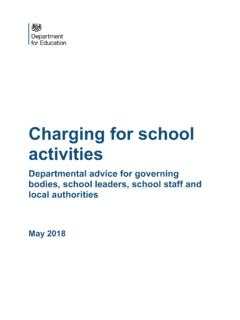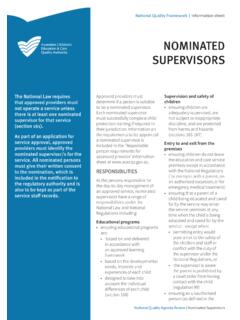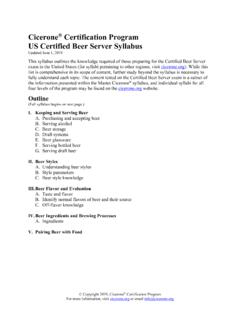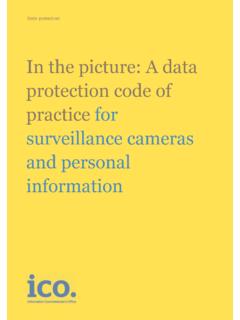Transcription of Advice on standards for school premises - GOV.UK
1 Advice on standards for school premises For local authorities, proprietors, school leaders, school staff and governing bodies March 2015 2 Contents Summary 3 standards for all Schools 4 The standards 5 Toilet and washing facilities 5 Medical accommodation 7 Health, safety and welfare 8 Acoustics 9 Lighting 11 Water supplies 12 Outdoor space 13 Other legislation on school premises 14 Further sources of information 15 3 Summary About this departmental Advice This is Advice from the Department for Education. This Advice is non-statutory, and has been produced to help recipients understand their obligations and duties in relation to the school premises Regulations 2012, which came into force on 31 October 2012, and Part 5 of the revised Education (Independent school standards ) (England) Regulations 20101, which came into force on 1 January 2013.
2 Expiry or review date This Advice was updated in March 2015 to take account of changes to linked regulations and guidance. It will next be reviewed in May 2016, when the need for any further Advice , or revisions to this Advice , will be assessed. Who is this Advice for? This Advice is primarily for: Local authorities, proprietors, school leaders and governing bodies in all schools in England It may also be useful for: school staff and parents Those involved in the design of school premises Key points There are fewer regulations than previously and they are less prescriptive, allowing schools more flexibility in how they use their premises . Many regulations state that provision must be suitable.
3 This is not precisely defined, but schools must take into account the age, number and sex of pupils, and any special requirements they have, when determining whether provision is suitable. This guidance advises on how to meet the regulations. It also provides signposts to other, more general, premises related legislation and guidance of relevance to schools. 1 As amended in 2012. 4 standards for all Schools This guidance describes, and advises on meeting the requirements of, the premises regulations for all types of schools in England. To aid clarity, the main regulations are included in a blue box before each piece of guidance. Background The Education Act 1996 places a duty on the Secretary of State to prescribe standards for the premises of all maintained schools in England and Wales2.
4 Those for England are set out in The school premises (England) Regulations 2012 (SPRs) and they apply to all existing and new schools maintained by a local authority3. Similarly, the Education Act 2002 empowers the Secretary of State to prescribe standards for the premises of independent schools, which include Academies (including alternative provision Academies) and Free Schools. These are set out in Part 5 of The Education (Independent school standards ) (England) Regulations 20104 (ISS). While there continue to be two sets of school premises regulations in place, their requirements are now identical and all types of schools now have to meet the same standards . This guidance therefore applies to all types of schools in England.
5 Land and buildings covered by the regulations A school s premises comprise all the land and all the buildings provided for the school , including both permanent and temporary buildings and detached playing fields. Interpretation Both sets of regulations include these clarifications of what is meant by the term suitable and what is meant by special requirements . Any requirement that anything provided under these Regulations must be suitable means that it must be suitable for the pupils in respect of whom it is provided, having regard to their ages, numbers and sex and any special requirements they may have. A pupil has special requirements if the pupil has any needs arising from physical, medical, sensory, learning, emotional or behavioural difficulties which require provision which is additional to or different from that generally required by children of the same age in schools other than special schools.
6 2 The Education ( school premises ) Regulations 1999 continue to apply to maintained schools in Wales. 3 The Regulations apply to nursery, community, community special, foundation, foundation special and voluntary schools and to pupil referral units. 4 As amended by the Alternative Provision Academies and 16 to 19 Academies (Consequential Amendments to Subordinate Legislation) (England) Order 2012 and the Education (Independent school standards ) (England) (Amendment) Regulations 2012. 5 The standards Toilet and washing facilities Numbers of fittings The regulations do not set the minimum number of fittings to be provided in relation to the ages and numbers of pupils.
7 Generally the needs of younger pupils are likely to be greater than those for older ones. So, for example, a provision of one toilet and washbasin for every ten pupils under 5 years old would be adequate, while that ratio could be doubled for pupils aged 5-11 to one toilet and washbasin for every 20 pupils. For pupils over 11 one toilet per 20 pupils would be sufficient, but there is scope to reduce the number of washbasins where the washing facilities are shared. ISS Regulation 23A (1) Subject to sub-paragraph (2), the standard in this paragraph is met if the proprietor ensures that a) suitable toilet and washing facilities are provided for the sole use of pupils; b) separate toilet facilities for boys and girls aged 8 years or over are provided except where the toilet facility is provided in a room that can be secured from the inside and that is intended for use by one pupil at a time; and c) suitable changing accommodation and showers are provided for pupils aged 11 years or over at the start of the school year who receive physical education.
8 (2) Where separate facilities are provided under sub-paragraph (1) (a) for pupils who are disabled, they may also be used by other pupils, staff, supply staff, volunteers and visitors, whether or not they are disabled. SPRs Regulation 4 (1) Subject to paragraph (3), suitable toilet and washing facilities must be provided for the sole use of pupils. (2) Separate toilet facilities for boys and girls aged 8 years or over must be provided except where the toilet facility is provided in a room that can be secured from the inside and that is intended for use by one pupil at a time. (3) Where separate facilities are provided under paragraph (1) for pupils who are disabled, they may also be used by other pupils, teachers and others employed at the school , and visitors, whether or not they are disabled.
9 (4) Suitable changing accommodation and showers must be provided for pupils aged 11 years or over at the start of the school year who receive physical education. 6 General planning Toilet facilities need to be planned and designed so that: a) hand washing facilities are provided within or in the immediate vicinity of every toilet; b) the rooms containing them are adequately ventilated and lit; c) they are located in areas around the school that provide easy access for pupils and allow for informal supervision by staff, without compromising pupils privacy. Where there is unisex provision (under ISS 23A (1) (b) or SPR 4 (2)), the privacy of the occupant needs to be ensured and this will be achieved by, for example, having adequate enclosure and a full height door.
10 Facilities for disabled pupils Each toilet for disabled pupils needs to contain one toilet and one washbasin (and possibly a shower or other wash down fitting) and have a door opening directly onto a circulation space that is not a staircase and which can be secured from the inside. Where possible, the number and location of accessible toilets will be sufficient to ensure a reasonable travel distance for users that does not involve changing floor levels5. Changing accommodation and showers for pupils It is preferable for showers to be in areas separated from toilets and they need to provide adequate privacy. Consideration may also be given to providing changing rooms, with or without showers, at primary schools for pupils who need to wear sports kit for physical education, but this is not required under the regulations.












